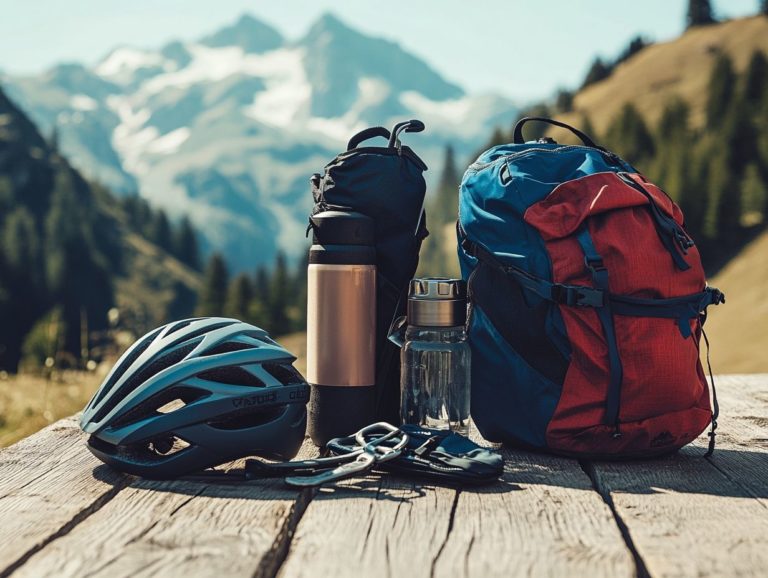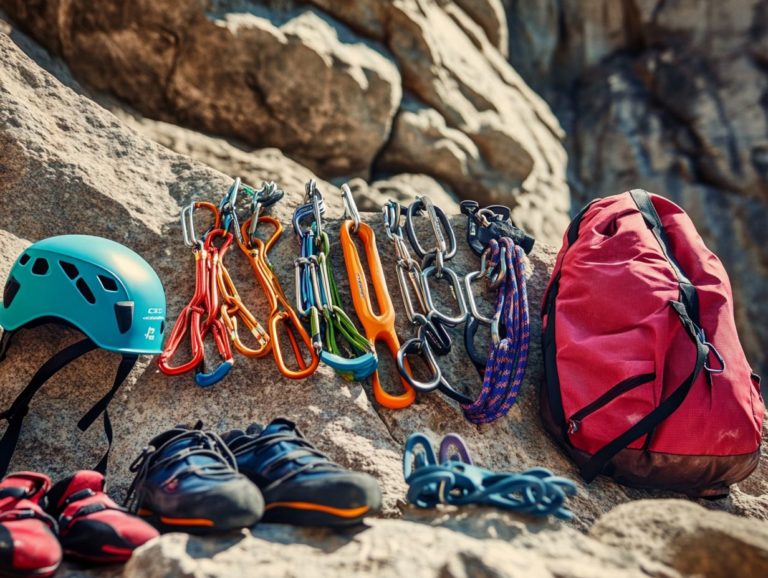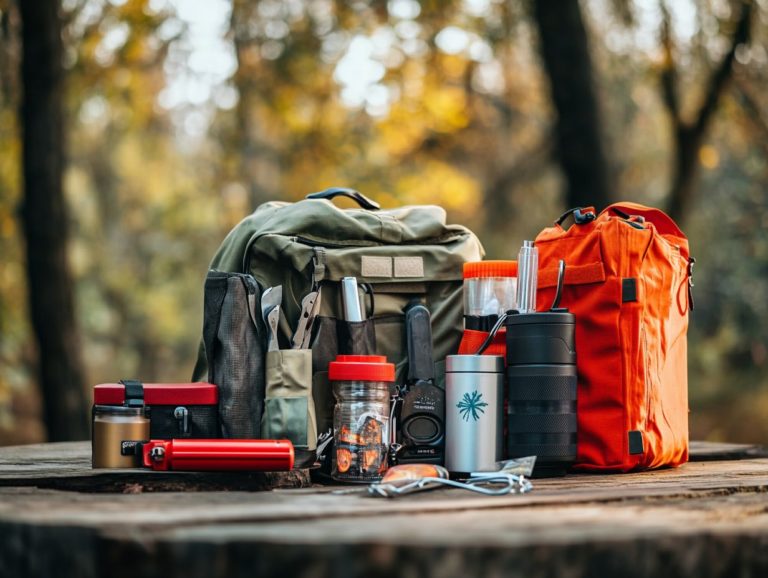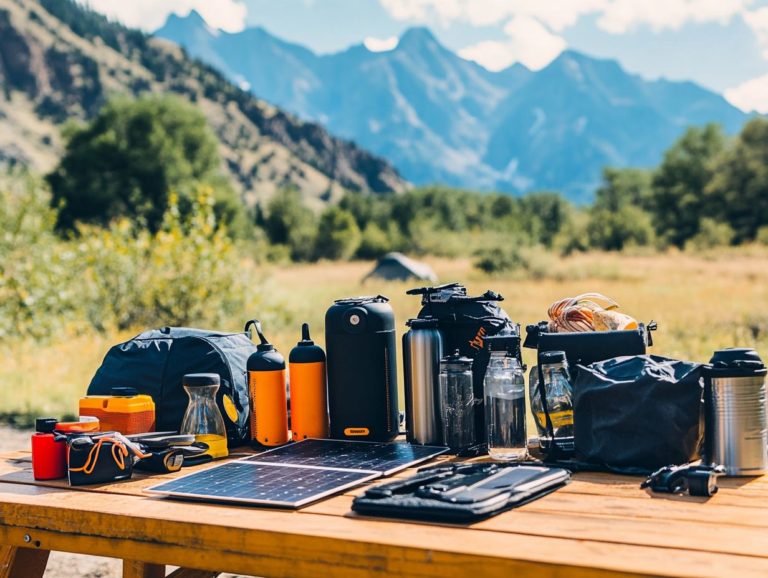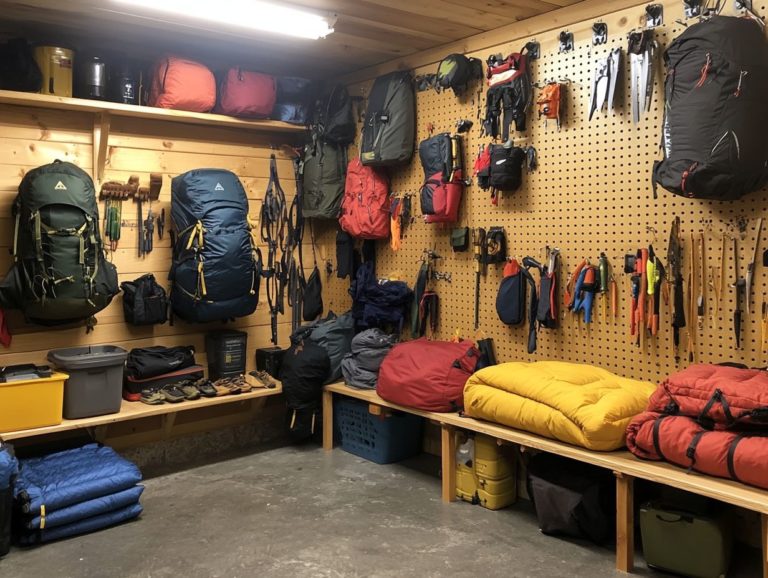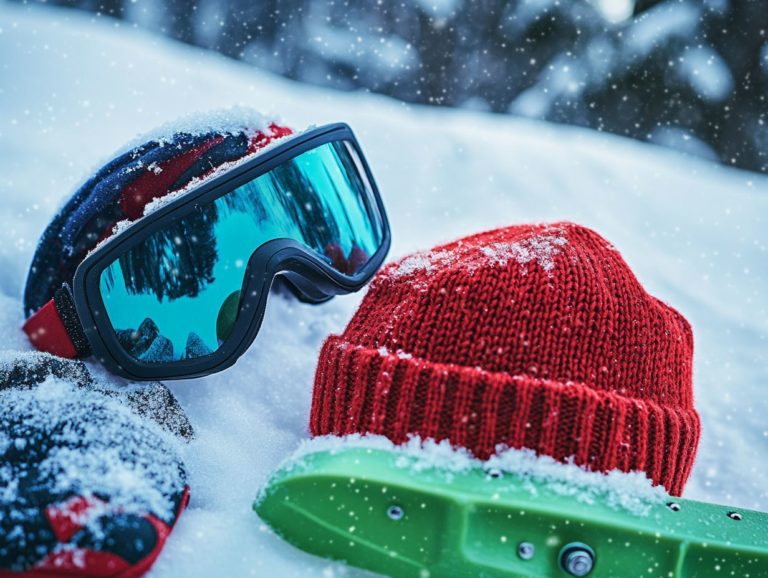Essential Accessories for Exploring National Parks
Planning a trip to a national park? The right accessories can truly elevate your adventure.
From comfortable backpacks to sturdy hiking boots, every item on this list is crafted to enhance your outdoor experience. Whether you re traversing rugged trails, shielding yourself from the sun, or capturing breathtaking moments with your camera, being well-prepared is essential.
Dive into this must-have guide and gear up for an unforgettable adventure!
Contents
- Key Takeaways:
- 1. A Comfortable and Durable Backpack
- 2. Sturdy and Supportive Hiking Boots
- 3. Lightweight and Quick-Drying Clothing
- 4. Sun Protection Gear
- 5. Water Bottle or Hydration Pack
- 6. Navigation Tools
- 7. First Aid Kit
- 8. Portable Phone Charger
- 9. Insect Repellent
- 10. Camping Gear
- 11. Binoculars
- 12. Camera
- 13. Portable Water Filter
- 14. Multi-Purpose Tool
- 15. Emergency Whistle
- What Are the Must-Have Accessories for a National Park Trip?
- What Are the Different Types of Backpacks and Their Features?
- How to Choose the Right Hiking Boots for Your Trip?
- What Fabrics and Features Should You Look for in Hiking Clothing?
- Why Is Sun Protection Important in National Parks?
- What Navigation Tools Are Essential for Exploring National Parks?
- What Should Be Included in a First Aid Kit for a National Park Trip?
- How Can You Stay Connected and Charged in the Wilderness?
- What Are the Best Ways to Protect Yourself from Insects in National Parks?
- What Are the Different Types of Camping Gear and Their Uses?
- 16. Outdoor Dining Essentials
- 17. Emergency Shelter Options
- 18. Understanding Wildlife Interactions
- 19. Preparing for Changing Weather Conditions
- Frequently Asked Questions
- What are some essential accessories for exploring national parks?
- What makes hiking boots essential for national parks?
- Is a backpack necessary for exploring national parks?
- Do I need to bring a map or GPS device to explore national parks?
- What type of sunscreen should I bring for exploring national parks?
- Why is insect repellent an essential accessory for exploring national parks?
Key Takeaways:
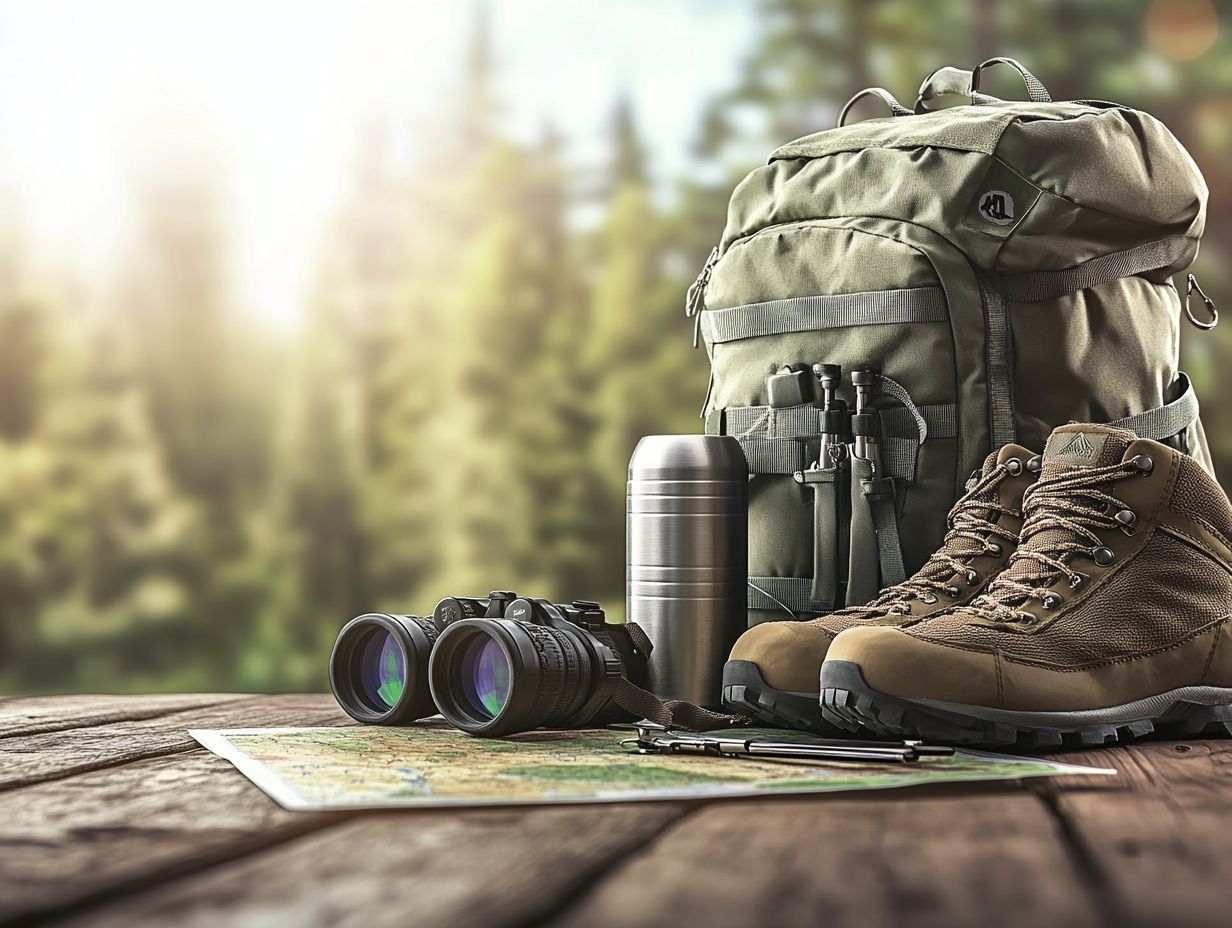
- A sturdy backpack with comfortable straps is essential for carrying all your gear while exploring national parks.
- Invest in durable and supportive hiking boots to protect your feet and ankles from rocky terrain.
- Opt for lightweight and quick-drying clothing to stay comfortable and dry throughout your national park adventures.
1. A Comfortable and Durable Backpack
A comfortable and durable backpack is essential for any wilderness adventure, especially when you’re exploring national parks. It ensures you can carry all your outdoor gear like hydration packs, camping chairs, and essential campsite items while keeping comfort intact on the trails.
When selecting the ideal pack, consider the various types designed specifically for hiking and camping. Look for options with adjustable straps for a customized fit.
Compartments for hydration systems are important, as they provide easy access to water without requiring you to stop. Some backpacks also work well with camping gear, making it effortless to attach items like sleeping bags or tents.
A multi-liter backpack can easily accommodate a Coleman cooler, seamlessly blending functionality with convenience for an enjoyable outdoor experience.
2. Sturdy and Supportive Hiking Boots
Sturdy and supportive hiking boots are essential for navigating the diverse terrains of national parks. They deliver the traction and comfort that enthusiasts appreciate in footwear like the Danner Trail 2650.
When selecting your ideal pair, it’s crucial to weigh several key features that can significantly elevate your hiking experience. Waterproofing is important for keeping your feet dry in unpredictable weather.
Insulation plays a key role in ensuring warmth during cooler excursions. A boot s grip can dramatically impact your stability on slick surfaces, making it essential for safety.
As you compare brands, you might find that while Merrell excels in comfort, Salomon often stands out for its durability. Be sure to try on boots with the actual hiking socks you intend to use for a snug and comfortable fit.
This guarantees a more enjoyable outdoor adventure, free from the perils of blisters or discomfort.
3. Lightweight and Quick-Drying Clothing
Lightweight and quick-drying clothing is essential for your outdoor adventures. It expertly manages moisture and temperature.
Items like thermal underwear and the Columbia Bora Bora II sun hat ensure your hikes in national parks remain comfortable and enjoyable.
When you venture into rugged terrains, the choice of materials becomes paramount. Merino wool shines with its natural moisture-wicking and temperature-regulating properties, keeping you warm without the risk of overheating.
Synthetic fibers like polyester and nylon offer exceptional durability and elasticity, giving you the stretch you need for unrestricted movement while maintaining comfort.
Employing effective layering techniques think of combining a moisture-wicking base layer with an insulating mid-layer and a breathable outer shell creates a versatile system ready to adapt to unpredictable weather.
Quick-drying fabrics are invaluable, ensuring moisture doesn t cling to your skin. This allows you to immerse yourself in your adventurous pursuits without a hint of discomfort.
4. Sun Protection Gear
Sun protection gear is absolutely essential for your outdoor adventures, particularly in national parks where the sun s intensity can be relentless. Packing sunscreen, SPF sticks, and sun hats should be at the top of your list. These essentials ensure effective UV protection as you explore the wilderness.
Consider using broad-spectrum SPF sunscreen, which protects against both UVA and UVB rays. This type of sunscreen delivers comprehensive protection, making it a savvy choice for those long hours spent outside.
For extra safety, lightweight, long-sleeved clothing and wide-brimmed hats act as physical barriers, offering shade and reducing sun exposure. Reapply sunscreen every two hours to stay protected and enjoy every moment outdoors!
Always choose UPF-rated fabrics for your clothing UPF stands for Ultraviolet Protection Factor, indicating how much UV radiation a fabric allows to reach your skin. This provides an additional layer of defense against harmful rays, allowing you to immerse yourself in nature without a care.
5. Water Bottle or Hydration Pack
Staying hydrated is essential while hiking in national parks. A quality water bottle or hydration pack like an Owala water bottle or a standard hydration backpack is crucial for efficiently carrying and treating water during your outdoor excursions.
When you compare the two, hydration packs generally boast larger capacities. This allows you to carry more water for those longer hikes without the need for frequent refills. On the other hand, water bottles are often more portable and easier to clean, but may require regular stops to replenish your supply.
Convenience is a key factor; hydration packs often come equipped with bite valves, enabling hands-free sipping especially beneficial during those strenuous stretches. In remote areas where clean drinking water might be hard to come by, utilizing water treatment options like filters or purification tablets ensures safe hydration, regardless of which option you choose.
Are you ready to explore the great outdoors with confidence? Navigation tools are essential for your outdoor adventures in national parks. Whether you opt for traditional maps, a reliable GPS system, or modern solutions like the AllTrails app paired with a trusty compass, each tool plays its part.
Understanding these tools is vital for safe navigation, particularly in diverse terrains where landmarks can be few and far between. Mastering the art of reading maps such as identifying elevation changes and trail markers empowers you to make informed decisions about your routes.
While GPS technology provides real-time location tracking, having a backup plan is crucial. Familiarizing yourself with paper maps can be a lifesaver. Digital trail maps offer interactive features and instant updates on trail conditions, often surpassing traditional paper maps in usefulness.
Utilizing apps like AllTrails not only elevates your navigation experience but also grants access to user-generated content that can enrich your hiking journey, making it all the more rewarding.
7. First Aid Kit
A well-stocked first-aid kit is your adventure buddy, ready for any surprise! It’s essential for any outdoor adventure, allowing you to be fully prepared for minor injuries and emergencies. Following an emergency preparedness guide will help you curate the perfect first-aid kit specifically designed for your national park visits.
As you venture into the wilderness, ensure your kit includes:
- a variety of bandages in different sizes
- a reliable antiseptic for cleaning wounds
- a selection of over-the-counter medications
Think pain relievers, antihistamines for those pesky allergic reactions, and perhaps blister pads if long hikes are on your agenda. Depending on your planned activities, you might also want to add specialized tools like a splint for potential fractures or gauze for larger wounds.
Each hiking expedition presents its own set of risks, so customizing the contents of your kit will enhance your readiness for whatever unexpected situations you might face.
8. Portable Phone Charger
A portable phone charger is an absolute must-have for any outdoor enthusiast. It ensures your devices stay charged for navigation, emergency communication, and capturing unforgettable moments as you explore the stunning beauty of national parks.
With a variety of options available, you can choose from high-capacity power banks for extended trips or lightweight models designed for day hikes. There are even innovative solar chargers that harness the sun’s energy. Selecting the right charger is crucial.
High-capacity chargers often feature multiple USB ports, allowing you to power several devices at once. However, keep in mind their weight if you’re backpacking over long distances.
Look for features like water resistance and built-in LED lights. These add extra functionality, making these chargers not just handy but incredibly versatile. Follow these tips to maximize your battery life while enjoying outdoor activities:
- Turn off unnecessary apps
- Lower your screen brightness
- Utilize battery-saving modes
You don t want to miss any moments of your adventure due to the worry of running out of power.
9. Insect Repellent
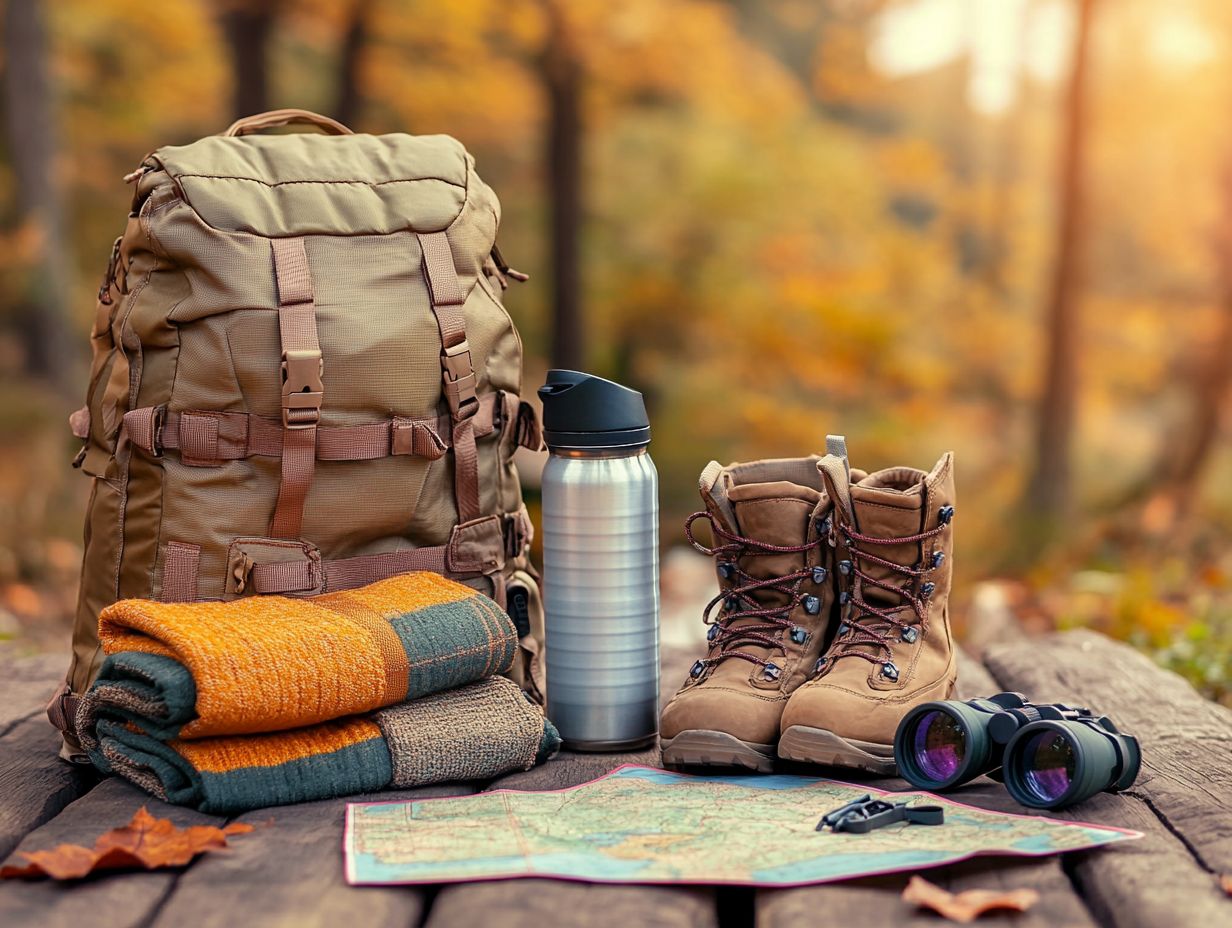
Insect repellent is an essential companion for outdoor enthusiasts, especially during summer months in national parks. A reliable bug spray can shield you from pesky bites and potential health risks associated with insects.
You ll find various formulations, including sprays, lotions, and wipes, tailored to your preferences and activities. Some may prefer natural insect repellents infused with essential oils, while others opt for chemical options like DEET, a common chemical found in bug sprays that effectively keeps insects away, or picaridin, known for its potency.
When selecting an insect repellent, make sure you find the most effective option for your needs. Don t forget to apply generously to all exposed skin and clothing to ensure your outdoor adventures remain enjoyable and, most importantly, bite-free.
10. Camping Gear
Camping gear is essential for elevating your wilderness adventure. It includes everything from camping equipment and Coleman coolers for food storage to portable tables for outdoor feasts and camping chairs that offer comfort and relaxation at your campsite.
Among the must-haves is the tent, which not only shelters you but also becomes your home away from home. Choosing the right one, whether it s a lightweight backpacking tent or a spacious family model, can make a significant difference in adapting to your camping style.
A high-quality sleeping bag is another game-changer, providing the comfort and warmth you need for a restful night beneath the stars. Don t underestimate the value of portable cooking equipment; the right stove or grill can transform your outdoor meals from simple to gourmet, making dining in nature a delightful experience.
Ultimately, investing in gear that aligns with your specific needs and preferences can significantly enhance your time spent in the great outdoors. Get your gear ready and explore the beauty of national parks!
11. Binoculars
Binoculars are invaluable for enhancing your national park experience. They allow you to engage in up-close wildlife watching while maintaining a respectful distance from animals in their natural habitats.
By selecting the right type of binoculars, you can significantly enhance your immersion in nature. With many options available, some are tailored for activities like birdwatching, hiking, or stargazing. When choosing your binoculars, consider features like magnification power, which typically ranges from 8x to 12x. This range strikes a balance between clarity and steadiness, ensuring you don t miss a single detail.
Waterproof and fog-proof capabilities are also essential, allowing you to tackle unexpected weather without compromising your adventures. If you find yourself hiking in rugged terrains, opting for lightweight models is the way to go.
To truly maximize your enjoyment, hold them steady and take your time focusing on objects, giving your eyes the chance to adjust for a clearer view.
12. Camera
A camera is an essential companion for capturing the breathtaking beauty of national parks. It allows you to document your adventures and create lasting memories through outdoor photography.
Among the multitude of camera options, DSLRs (Digital Single-Lens Reflex) and mirrorless models stand out for their versatility and exceptional image quality. These cameras are ideal for immortalizing stunning landscapes and the intricate details of wildlife. If you thrive on movement, action cameras are your best bet. Their compact size and durability enable you to capture dynamic moments even in challenging environments.
Understanding lighting is crucial when photographing nature. The golden hours just after sunrise and right before sunset offer soft, diffused light that brings colors and shadows to life. Using composition techniques like the rule of thirds can elevate your images. A bit of patience and careful observation will also help you capture wildlife in its natural habitat.
13. Portable Water Filter
A portable water filter is essential for adventurers in national parks, ensuring access to clean and safe drinking water. Consider products like Sawyer Products for effective water treatment during your hikes.
This reliable equipment is a lifeline, especially in remote areas where water sources may be murky or contaminated. With various portable filters available including activated carbon filters, gravity filters, and pump filters each type has unique advantages tailored to your needs.
- Activated carbon filters remove impurities and odors from water, enhancing taste.
- Gravity filters provide a hands-free approach, perfect for larger groups.
When planning your outdoor excursion, knowing when to use these devices can save your life! Treat water from streams immediately after collection. Pre-filter muddy water through a cloth to ensure safety, and regularly clean your filter to maintain its efficiency!
14. Multi-Purpose Tool
A multi-purpose tool can be your best friend in the wild. It offers a versatile range of functions that assist you in various situations during your outdoor adventures in national parks.
These clever devices typically combine features like pliers, screwdrivers, knives, and bottle openers into a compact design. They are incredibly useful for tasks ranging from opening cans of food to executing emergency repairs on your equipment.
Imagine needing to fix a camping stove or cut some rope. Having one of these tools at your side can truly make a difference! Their convenience is unmatched, especially during treks where space is limited.
By keeping this tool within easy reach, you can approach unexpected challenges with confidence and ease, enhancing your overall outdoor experience.
15. Emergency Whistle
An emergency whistle is an invaluable piece of safety gear for outdoor enthusiasts. It serves as a reliable means to signal for help during your explorations in national parks.
In situations where your voice may be compromised by distance, wind, or physical exertion, this small tool boosts your chances of being heard. Use it effectively by producing a series of three short blasts a universally recognized distress signal.
Integrating the whistle into your emergency preparedness plan is crucial. Attach it to your keychain or store it in an easily accessible pocket within your backpack. Regular practice with the whistle builds confidence and familiarity, making it an essential companion as you venture into the great outdoors.
Prepare yourself for adventure with these essential tools!
What Are the Must-Have Accessories for a National Park Trip?
For an enjoyable and safe visit to national parks, there are several must-have accessories that can significantly enhance your wilderness experience. They ensure you re well-prepared for any adventure. Quality camping equipment, outdoor dining essentials, and reliable navigation tools are essential.
Choosing the right safety gear is crucial. A sturdy first aid kit, a reliable flashlight, and a whistle can be lifesavers in unpredictable situations.
Next, consider your dining supplies. Lightweight cookware, portable utensils, and durable, reusable plates can make meal prep effortless without adding unnecessary weight to your pack.
Regarding navigation tools, a good map or GPS device will keep you on track and elevate your journey. To maximize utility, opt for high-quality products that are compact, weather-resistant, and user-friendly. Additionally, consider incorporating must-have accessories for glamping into your gear. With the right equipment, every outing can turn into an unforgettable adventure!
What Are the Different Types of Backpacks and Their Features?
You ll find a variety of backpacks designed for different outdoor activities, each boasting unique features tailored to specific needs. Whether you re eyeing multi-liter backpacks for extended trips or lightweight options perfect for day hikes in national parks, there s something for you.
Daypacks typically range from 15 to 30 liters, making them ideal for carrying essentials on short excursions. If you re planning a longer trek, hiking backpacks can hold 40 liters or more. They come equipped with specialized compartments for your gear, food, and clothing. Don’t overlook hydration packs; these compact options integrate a water reservoir to keep you refreshed while you re on the move.
When selecting the right backpack, consider factors like the duration of your adventure, the terrain you ll be navigating, and how much weight you can comfortably carry. Features like adjustable padded straps and hip belts significantly enhance your comfort and stability, ensuring that even your longest journeys remain enjoyable.
How to Choose the Right Hiking Boots for Your Trip?
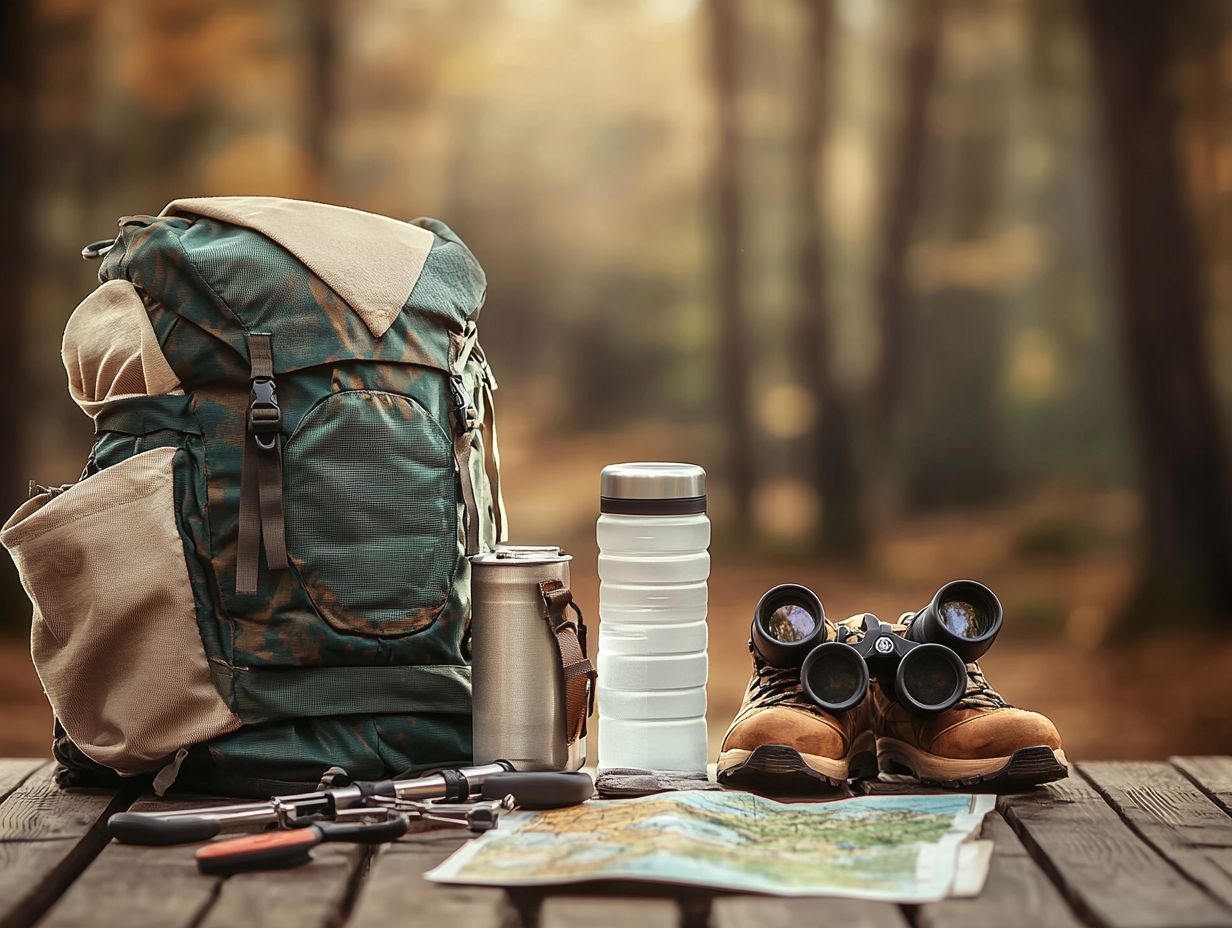
Choosing the right hiking boots is essential. They provide the necessary support and protection for your outdoor adventures. When selecting boots like the Danner Trail 2650 or other hiking shoes, you’ll want to consider factors such as fit, breathability, and traction.
Assess the terrain you’ll be navigating whether it’s rocky paths, muddy trails, or steep inclines. Each scenario demands specific characteristics in your footwear. Distance is another key factor; longer hikes may require a more cushioned boot to help mitigate fatigue. Don t overlook your personal comfort preferences; think about weight, flexibility, and arch support.
Proper fitting is crucial. Your boots should accommodate any swelling of your feet over time. Don’t wait try on several sizes to find the perfect fit! It s also wise to break in new boots before embarking on longer hikes; this practice helps prevent blisters and ensures a more enjoyable experience outdoors.
What Fabrics and Features Should You Look for in Hiking Clothing?
When selecting hiking clothing for your national park adventures, prioritize fabrics that are quick-drying and draw sweat away from the skin. Look for essential features such as breathability and insulation, especially with thermal underwear for those chillier climates.
Layering keeps you comfortable and protected from unpredictable weather. Start with a base layer, often crafted from merino wool or synthetic blends, which is crucial for effective moisture management.
Next, incorporate a mid-layer to provide insulation, keeping you warm when the temperatures dip.
Finally, an effective outer shell will guard you against wind and rain. Look for features like waterproof zippers and adjustable hoods that add to the functionality of your gear.
By thoughtfully combining these materials, you ll be ready to embrace everything from brisk mornings to warm afternoons, ensuring a truly enjoyable outdoor experience.
Why Is Sun Protection Important in National Parks?
Sun protection is essential when you’re exploring national parks because of the high levels of UV exposure. Sunscreen and SPF sticks are your best friends when it comes to protecting your skin.
In areas with sparse tree cover, the intensity of UV rays can drastically increase. This puts you at a greater risk for sunburn and long-term skin complications. You need to take sun protection seriously to avoid harmful effects!
As you venture outdoors, consider various forms of sun protection. Here are some effective options:
- UV-protective clothing
- Wide-brimmed hats
- Sunglasses
These can add crucial layers of defense against harmful rays. If you re planning on extended outings, opting for apparel that protects against harmful sun rays is a smart move. By combining these strategies, you can enjoy a safer and more enjoyable experience while soaking in the stunning beauty of your surroundings.
Essential navigation tools for your national park adventures include a reliable GPS system and a traditional compass. These instruments are key to ensuring safe and efficient route planning during your outdoor excursions.
While GPS devices are convenient and provide real-time updates on trails, they have their challenges. If your battery dies or connectivity falters in remote areas, you could find yourself in trouble. This is where a traditional compass excels, offering a reliable method for navigation without needing power.
Equipping yourself with various tools such as detailed maps, handheld GPS units, and smartphone applications creates a broader safety net to help you navigate effectively. Additionally, having the right gear is crucial; check out the top hiking gear accessories you need to adapt your strategies and avoid the disorienting experience of getting lost in the wilderness.
What Should Be Included in a First Aid Kit for a National Park Trip?
A well-prepared first aid kit is an essential part of your emergency preparedness strategy. It should contain items like band-aids, antiseptic wipes, and pain relievers to help you manage common injuries.
It’s important to customize this kit to suit your personal needs since every hiker faces different challenges based on their environment, the season, or individual health concerns. For example, if you have a known allergy, packing antihistamines is a must.
Certain trails may expose you to unique risks such as insect bites or harsh weather conditions. Therefore, including tools like tweezers for splinters or heat packs for warmth can be invaluable.
Developing this kit not only enhances your safety but also boosts your confidence. You ll feel better knowing you have what you need to enjoy nature without unnecessary worry.
How Can You Stay Connected and Charged in the Wilderness?
Staying connected and charged in the wilderness can be challenging. Incorporating portable chargers and battery packs into your camping gear ensures that your devices are ready for navigation and emergency communication.
To maximize your battery life during outdoor adventures, activate power-saving modes on your devices. This simple step can extend usage by dimming the screen and curtailing background activities, making a significant difference when you’re off the grid.
Using proper charging techniques, like avoiding extreme temperatures and using solar chargers, can help keep your battery in top shape. It s also wise to have a reliable backup plan for communication in case of unexpected situations. Think about packing a lightweight satellite phone or even a trusty whistle for signaling.
By prioritizing these strategies, you can stay prepared and connected while fully enjoying the great outdoors. Prepare now to enjoy your adventure fully!
What Are the Best Ways to Protect Yourself from Insects in National Parks?
Protecting yourself from insects while hiking in national parks is crucial. Using effective insect repellent and bug spray is key to keeping pesky bugs at bay and ensuring a more enjoyable outdoor experience.
You ll find a variety of insect repellents available on the market. These range from chemical sprays containing DEET (a common insect repellent ingredient) to natural options infused with essential oils like citronella and eucalyptus. Chemical repellents often provide longer-lasting protection, but natural alternatives might be your go-to if you prefer eco-friendly solutions.
When planning your outdoor adventures, apply your chosen repellent before heading out. Focus on exposed areas like your arms, legs, and neck. Don t forget to reapply every few hours to stay protected! It s also a smart move to target areas near standing water, where insects thrive especially at dawn and dusk when they re most active.
What Are the Different Types of Camping Gear and Their Uses?
Understanding the various types of camping gear and their specific uses is essential for a fun camping trip. Think of essentials like a Coleman cooler to keep your food fresh, portable tables for comfortable dining, and specialized equipment tailored to your favorite activities.
Selecting the right gear isn’t just about having fun; it’s about ensuring your comfort, safety, and convenience in the great outdoors. Your sleeping gear should range from lightweight sleeping bags perfect for warm nights to insulated pads designed for chilly conditions, all aimed at enhancing your comfort beneath the stars. To further enhance your experience, consider the top 10 must-have accessories for camping trips.
When it comes to cooking, having the right gear can elevate your meal prep. Portable stoves and cookware allow you to whip up gourmet dishes even in the wild! And let’s not forget about safety equipment. Items like first-aid kits and multi-tools are essential. To enhance your outdoor experience, check out essential outdoor accessories for every adventurer. They prepare you for the unexpected, ensuring that every adventure is enjoyable and secure.
16. Outdoor Dining Essentials
Outdoor dining essentials elevate your camping experience, allowing you to savor meals in nature. Imagine portable tables and comfortable camping chairs creating the ideal setup for alfresco dining.
A dedicated outdoor dining arrangement brings convenience and comfort. You can bask in the beauty around you while enjoying your meals. Essential items like lightweight cooking utensils and durable dishes simplify meal prep and serving, while a sturdy cooler keeps your refreshments chilled and within reach.
Consider investing in a compact outdoor rug to create a cozy atmosphere that defines your dining space. With the right gear in place, each meal becomes a cherished moment, encouraging you to relax and savor the delightful experience of dining under the open sky.
17. Emergency Shelter Options
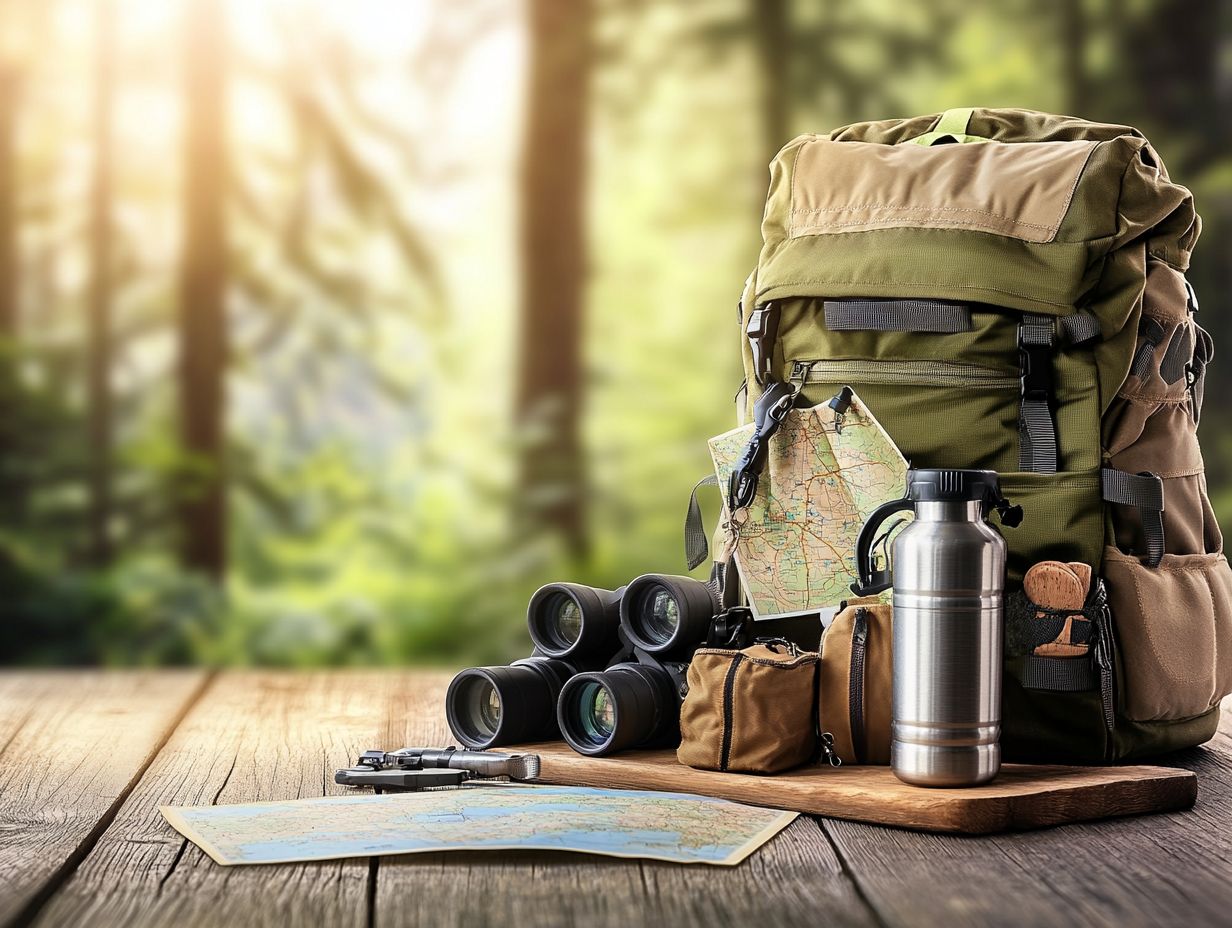
Emergency shelters are your lifeline in the wilderness! Having effective emergency shelter options is essential for your safety. It’s all about protecting yourself from the elements, and various camping gear, like tents and tarps, can fulfill this critical role during your outdoor adventures.
In unpredictable weather, these shelters become absolutely essential. Tents offer a strong barrier against wind and rain. Tarps provide a lightweight and versatile alternative that adapts easily to different environments.
If you’re leaning towards minimalism, bivy sacks are an efficient choice, delivering essential protection with minimal setup.
No matter which option you choose, mastering the art of quickly erecting these structures is fundamental. Familiarize yourself with the setup process beforehand to save precious time in emergencies. This can make all the difference in ensuring your safety when it matters most.
Gear up now to make the most of your next trip!
18. Understanding Wildlife Interactions
Get ready for an unforgettable adventure as you explore the wonders of nature! Understanding wildlife interactions is essential for any national park trip, as it enhances your wildlife watching experience while ensuring your safety and honoring the natural surroundings.
By embracing best practices, you can fully appreciate the beauty of these creatures while minimizing disturbances. It s crucial to maintain a safe distance when observing wildlife; this not only safeguards you but also allows the animals to behave naturally.
Educating yourself about animal habits can reveal fascinating insights into their behavior, leading to more rewarding encounters. Equip yourself with safety gear like binoculars for a closer view without intruding. Pack your bear spray for those unexpected encounters it boosts your confidence and gives you peace of mind!
Wearing earth-toned clothing helps you blend into the environment, enhancing your experience.
19. Preparing for Changing Weather Conditions
Preparing for unpredictable weather conditions is essential when exploring national parks. The weather can change in the blink of an eye, so having rain gear, thermal underwear, and a thorough emergency preparedness guide is crucial for your comfort and safety.
Before you set out, it s wise to check reliable weather forecasts using apps or websites that provide real-time updates for your area. Sudden changes can happen, and keeping an eye on alerts will empower you to make timely decisions.
Layering techniques are your best friend during these adventures. Opt for shirts that keep you dry, insulating middle layers, and waterproof outer layers to adapt to fluctuating temperatures and unexpected rain.
Don t forget to pack backup clothing and gear, like extra socks, gloves, and a compact poncho. Being prepared for extreme weather conditions ensures you re ready for anything, allowing you to focus on enjoying the experience.
Frequently Asked Questions
What are some essential accessories for exploring national parks?
Some essential accessories for exploring national parks include a good pair of hiking boots, a backpack, a map or GPS device, sunscreen, and insect repellent.
What makes hiking boots essential for national parks?
Hiking boots provide support and protection for your feet on rugged and uneven terrain, preventing potential injuries and allowing you to explore the park comfortably for longer periods.
Is a backpack necessary for exploring national parks?
Yes! A backpack is necessary for carrying essential items such as water, snacks, a map, and other gear. It also allows you to keep your hands free to climb and navigate through the park.
Do I need to bring a map or GPS device to explore national parks?
It is highly recommended to bring a map or GPS device to explore national parks, especially if you are not familiar with the area. These tools can help you navigate through the park and ensure you do not get lost.
What type of sunscreen should I bring for exploring national parks?
It is best to bring a sunscreen with a high SPF and one that is water-resistant. This will protect your skin from the sun’s rays, even if you are sweating or come into contact with water while exploring.
Why is insect repellent an essential accessory for exploring national parks?
Keep those pesky bugs at bay! National parks are home to various insects, including mosquitoes and ticks, which can carry diseases. Insect repellent helps protect you from bites and ensures you enjoy your adventure worry-free.

